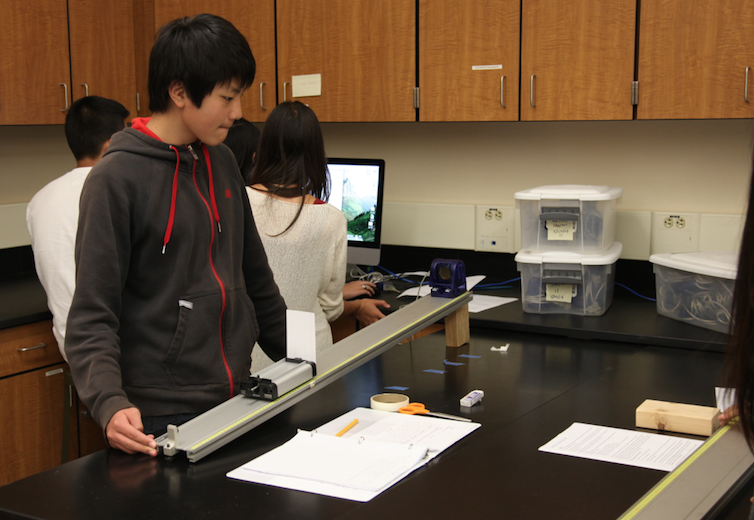Flipped classroom teaching style introduced
Junior Adrian Wong works in his Physics Honors class, one of the courses that has adapted the new flipped classroom approach.
This school year, the administration is introducing the “flipped classroom” to certain Physics Honors and Biology classes and modifying the dynamic of these classes to include blended learning.
Blended learning is a form of education where supplemental material is delivered to the students through technology.
Palo Alto Unified School District is increasing the presence of technology at several of its schools by implementing blended learning in subjects ranging from English to Math.
In a flipped classroom, students are required to watch lectures at home online, so that teachers are able to have more in-class interaction time with them. Students are then able to have one-on-one time with the teacher to ask questions and do practice problems.
Contrary to the traditional classroom where teachers lecture in class and assign homework for students to do in their own time, the flipped classroom aims to allow students to pace their own learning and give teachers more time to assist them.
Two Physics Honors classes instructed by Gul Eris, along with several Biology classes instructed by William Erlendson and Mindy Steiner, are implementing the flipped classroom, having students watch video lectures at home and take online quizzes to confirm they have watched the lectures.
In the classroom, there is increased emphasis on in-class and laboratory activities. Over the course of the past year and last summer, 17 Paly teachers have undergone blended learning training and 15 more are scheduled to train this year.
Principal Kim Diorio is enthusiastic about this learning strategy’s deviation from the structure of the traditional classroom.
“I think [blended learning is] really great because it puts the student at the center of their learning and also allows students to pace the material in a way that’s a little more appropriate for them than a traditional classroom, where the teacher is just standing in front of the board and doing direct instruction,” Diorio said.
The implementation of the flipped classroom at Palo Alto High School has been part of a growing effort to merge technology and education.
“We’re really trying to get to the point where we have a device for every student and I would love to see in the next three or four years that [students] bring [their] own devices into class,” Diorio said. “I think that’s just where we’re heading in technology and in the world.”
Junior Arjun Vasudevan, who is enrolled in a flipped Physics Honors class, echoes Diorio’s sentiments about the new blended learning approach.
“I think [the flipped classroom] is great because it gives students the opportunity to watch the videos and learn the material at their own pace, and frees up class time for more labs and activities,” Vasudevan said.
However, supportive sentiments of the blended learning approach are not unanimous amongst all Paly students.
Junior Adele Bloch feels that the flipped classroom is not beneficial to her overall learning experience.
“[Because of the flipped classroom], I am forced to go learn a subject at home that I probably will not understand, and the following day I must implement the knowledge that I am yet to attain,” Bloch said. “I feel like I am not properly learning the basic knowledge when I teach myself from home and I often do not feel confident in the answers that I have with this new flipped classroom.”
Bloch went on to comment on the various benefits of the traditional classroom.
“I learn best when teachers specifically give me the information I must know,” Bloch said. “I enjoy learning during the allotted time period at school and I like having to figure out the problems at home based off of the knowledge that I’ve gained at school, not vice versa.”
Your donation will support the student journalists of Palo Alto High School's newspaper

